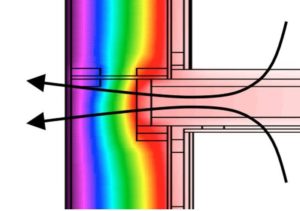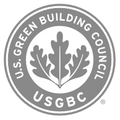So you are ready to insulate your living space and R-Value is top of mind. And rightfully so, it is the most widely accepted measure of insulation and often aligns with a minimum code requirement. But assuming that your wall assembly will realize the R-Value of your insulation ignores a crucial variable in building science… thermal bridging. Understanding and managing for thermal bridging will not only make your living space more comfortable, it will also save you money. Let’s dig into some high-level basics.
What is thermal bridging?
Thermal bridging is when a particularly conductive (or poorly insulating) material let’s heat flow across a thermal barrier. Physics dictates that hot wants to go to cold and a thermal bridge is a perfect invitation. Think studs within an insulated wall. The insulation on either side of a stud will do its job of limiting heat flow but the wooden stud, which has a much lower R-Value, will not. These bridges can become superhighways of heat loss.

How does this work in a home?
Let’s continue with the stud example. The typical R-Value of a 2×4 wooden stud is 4.4 while the insulation on either side is much higher – typically >R13. As discussed, the result of this bridge is heat transfer and a significant loss in the wall’s effective R-Value. In a wood stud wall with R20 insulation, thermal bridging can reduce the effective R-value to as low as R15. An even worse thermal bridge is a metal stud that can cut effective R-Value by as much as 80%. Along with studs, other typical building materials that create thermal bridges are metal fasteners, plates, headers, and windows. Typically you can observe these all around a house – roofs, walls, fenestrations for example.
The Impacts of Thermal Bridging
So if you are losing heat through thermal bridges either into or out of your living space, the efficacy of your climate control system decreases (and uses more energy!) plus it’s just not as comfortable. Lose-Lose. Further, these bridges can create cold spots within your walls where condensation can easily form. This moisture can produce a whole host of issues to the wall cavity…. mold and mildew or rot, to name a few. Excessive moisture also challenges the structural integrity of your wall.
OK, so how do we prevent or limit thermal bridging?
Luckily advancements in building science and common sense can really help limit thermal bridging. Realistically most homes will have some going on but there are tools at our disposal.
Here are some ways to effectively address this issue:
Exterior insulation: Maybe a better term would be “out-sulation”. The premise is simple. By wrapping the exterior of your home in insulation you can prevent (or dramatically reduce) the common thermal bridging via wall studs. Cork is a great option as is Gutex (wood fiber exterior insulation); each is becoming more commonplace.
Advanced house framing or Optimum Value Engineering: The goal of this building technique is to reduce lumber used in framing which reduces thermal bridging. Lots of strategies are incorporated here including spacing wall studs up to 24 inches on center, eliminating headers in non-load-bearing walls, designing on two-foot modules to make the best use of common sheet sizes, and to reduce waste.
Insulated studs: The company T Stud produces an R19 stud that is a thermally broken, insulated wall stud assembly. They also have the BareNaked Tstud™ which is an uninsulated, thermally broken wall stud that you can insulate with the insulation of your choice. These studs can not only reduce thermal bridging, but they are incredibly strong.
“Alternative” Wall Assemblies: Structural Insulated Panels (SIPs) are a common alternative to stick-built construction and can help limit thermal bridging. These panels have an insulated foam core between two rigid board sheathing materials which when installed properly can provide a continuous air and vapor barrier. There are issues, however, including the use of foam. Bamcore makes a bamboo wall system that is an environmentally friendly, extremely high-performance option.
And a word on air sealing
In the broader discussion of efficient building, air sealing is a critical consideration. Solving for thermal bridging is great, but if your structure leaks air, you’ve still got problems. When air moves within insulation it substantially reduces the thermal performance. It can also create bulk water vapor penetration which brings a whole host of issues. More on this topic to come. Til then solve for air sealing with vapor variable membranes, not vapor barriers.





